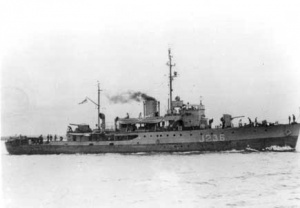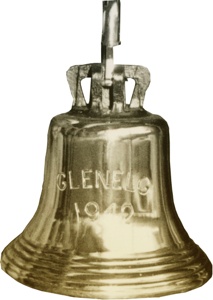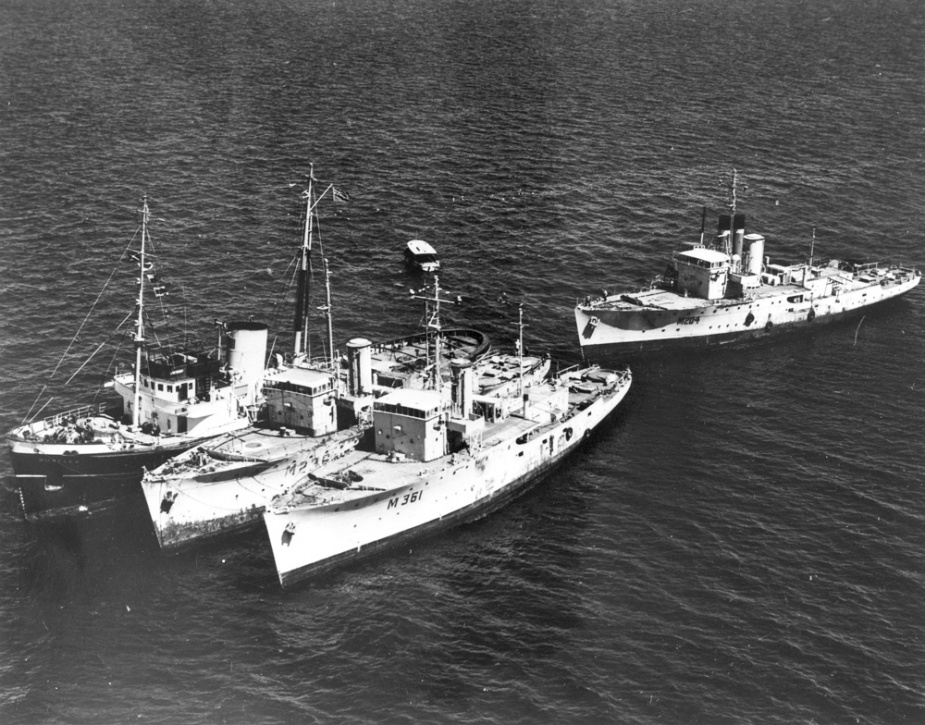HMAS Glenelg (I)
| Class |
Bathurst Class |
|---|---|
| Type |
Austraian Minesweeper |
| Pennant |
J236, M236 |
| Builder |
Cockatoo Docks and Engineering Co Ltd, Sydney |
| Laid Down |
2 March 1942 |
| Launched |
25 September 1942 |
| Launched by |
Mrs Evatt, wife of the Minister for External Affairs |
| Commissioned |
16 November 1942 |
| Decommissioned |
14 January 1946 |
| Dimensions & Displacement | |
| Displacement | 650 tons |
| Length | 186 feet |
| Beam | 31 feet |
| Draught | 10 feet |
| Performance | |
| Speed | 15 knots |
| Propulsion | |
| Horsepower | 2000 |
| Armament | |
| Guns | 1 x 4-inch gun |
| Other Armament |
|
| Awards | |
| Battle Honours | |

HMAS Glenelg was one of sixty Australian Minesweepers (commonly known as corvettes) built during World War II in Australian shipyards as part of the Commonwealth Government's wartime shipbuilding programme. Twenty were built on Admiralty order but manned and commissioned by the Royal Australian Navy. Thirty six (including Glenelg) were built for the Royal Australian Navy and four for the Royal Indian Navy.
HMAS Glenelg was laid down at Cockatoo Docks and Engineering Co Ltd, Sydney, NSW on 2 March 1942. She was launched on 25 September 1942 by Mrs Evatt, wife of the Minister for External Affairs, and was the first RAN warship to carry the name of the beachside suburb of Adelaide, SA.
Glenelg commissioned at Sydney on 16 November 1942 under the command of Lieutenant Alfred F Summerfield RANR(S).
The early months of the Glenelg's career were spent escorting convoys from Queensland ports to New Guinea. In May 1943 she began operating as escort for Sydney to Brisbane convoys. In December she began a refit.
In January 1944 Glenelg returned to the New Guinea area and remained there in constant service on patrol and escort duties until the end of the year. In the early period she operated on patrol off Milne Bay and the entrance to China Strait and later escorted shipping to Langemak, Manus, Saidor, Morotai, Hollandia, Madang and Cape Gloucester. A considerable period was spent on patrol in Dutch New Guinea waters. Constantly operational, Glenelg covered a wide area, steaming 42,000 miles and being some 10,000 hours under way.
Since the Allied forces were at this period in control of the sea and air in the New Guinea area, most of the period passed without action. Nevertheless, in October 1944 Glenelg was able to render signal aid to a sorely harassed American patrol at the mouth of the Woske River near Maffin Bay, Dutch New Guinea. On 20 October the ship, proceeding close inshore, observed the American detachment under severe mortar fire. An appeal for assistance to evacuate wounded met with a ready response from volunteers to man Glenelg's whaler and it was quickly despatched under Lieutenant WH Pennington. Swamped by heavy surf the waterlogged boat was beached by her crew, and its bottom boards used as improvised stretchers to carry the wounded to the American held bank of the river.
Meanwhile, on a request for bombardment support, Glenelg opened fire with her 4-inch gun. Under cover of this fire (31 rounds), which effectively silenced the Japanese mortars, the American party was able to withdraw to cover with all wounded, leaving five dead on the beach. Lieutenant Peebles (United States Army), the senior surviving officer, was emphatic that the fire laid down by Glenelg and directed from the open beach by Lieutenant Pennington and Signalman Greet, was the decisive factor in the successful withdrawal.
In December 1944 Glenelg returned to Australia and arrived at Melbourne on 2 January 1945 to commence a refit, which was completed in February. On 16 March she departed Sydney for Manus to resume operational duty. The remainder of the period to the close of hostilities was taken up chiefly by escort of Morotai and Biak convoys. In early August she escorted a convoy to Leyte Gulf in the Philippines and spent some time in the Borneo area. On 12 August, three days before hostilities ended, Glenelg entered Darwin Harbour. She had steamed 103,027 miles on active operational duty.
In September Glenelg took part in the reoccupation of Ambon and remained in the Celebes area during the following month. On 1 November she departed Ambon for Fremantle, via Morotai, Townsville, Sydney, Melbourne and finally Glenelg, after which she had been named.
Glenelg paid off into Reserve at Fremantle on 14 January 1946. At the end of November 1945, while en route from Melbourne to Glenelg, the ship had steamed 110,019 miles since commissioning. On 2 May 1957 Glenelg was sold for breaking up to Hong Kong Rolling Mills Ltd of Hong Kong.


















